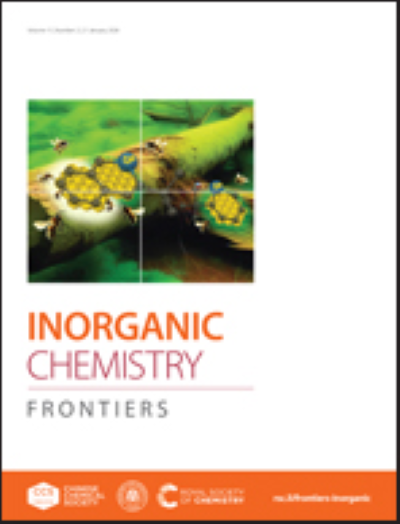Fe(II)-Ag(I)双金属hofmann型框架的光化学[2+2]反应调谐自旋交叉协同性
IF 6.1
1区 化学
Q1 CHEMISTRY, INORGANIC & NUCLEAR
引用次数: 0
摘要
光响应自旋交叉(SCO)化合物由于其可调节的光波长/能量和远程切换的能力而特别吸引人。本文将3-苯基吡啶(3-spy)配体引入二维Fe(II)-Ag(I)双金属hofmann型框架中,构建了光响应的SCO化合物[Fe(3-spy)2{Ag(CN)2}2](1)。在辐照在365 nm,遍访C = C双键3-spy配体1进行pedal-like构象运动和一个光化学[2 + 2]环加成反应,导致结构性障碍而导致更多的正则环丁烷在上海合作组织协调几何中心产品(Fe (hh-rctt-1 2-ppcb) {Ag (CN) 2} 2] (2) (hh-rctt-1 2-ppcb = hh-rctt-1,以叔(3-pyridyl) 3, 4-bis(苯基)环丁烷,r =参照群体,C =独联体和t =反式,hh =肉搏战)。这些结构变化对SCO的协同性和SCO中心的配体场产生了相反的影响。对不同辐照时间下SCO行为的研究表明,SCO的合作行为从1中的两步SCO逐渐转变为2中的不完全渐进的一步SCO。值得注意的是,T1/2(表示γHS = 0.5的中间自旋态)几乎保持不变,这表明在这个独特的光化学[2+2]反应集成的SCO体系中,只有SCO的协同性被显著调节。此外,在254 nm照射下,观察到2中的环丁烷部分立体选择性切割,这表明构建光切换SCO材料的潜力。本文章由计算机程序翻译,如有差异,请以英文原文为准。
Photochemical [2+2] reaction-tuned spin-crossover cooperativity in an Fe(II)-Ag(I) bimetallic Hofmann-type framework
Photo-responsive spin-crossover (SCO) compounds are particularly appealing due to their adjustable wavelength/energy of light and the capability for remote switching. Herein, we introduce the 3-styrylpyridine (3-spy) ligand into a 2D Fe(II)-Ag(I) bimetallic Hofmann-type framework to construct a photo-responsive SCO compound [Fe(3-spy)2{Ag(CN)2}2] (1). Upon irradiation at 365 nm, the criss-crossed C=C double bonds of 3-spy ligands in 1 undergo a pedal-like conformational motion and a photochemical [2+2] cycloaddition reaction, leading to the structural disorder but resulting in a more regular coordination geometry around the SCO center in the cyclobutane product [Fe(hh-rctt-1,2-ppcb){Ag(CN)2}2] (2) (hh-rctt-1,2-ppcb = hh-rctt-1,2-bis(3-pyridyl)-3,4-bis(phenyl)cyclobutane, r = reference group, c = cis and t = trans, hh = head-to-head). These structural changes exert opposite influences on SCO cooperativity and the ligand field of SCO center. Studies of SCO behavior under different irradiation times revealed that the SCO cooperative behavior gradually shifts from a two-step SCO in 1 to the incomplete and gradual one-step SCO in 2. Notably, T1/2, which represent the intermediate spin state where γHS = 0.5, remains almost unchanged, indicating only the SCO cooperativity is significantly modulated in this unique photochemical [2+2] reaction-integrated SCO system. Moreover, upon irradiation at 254 nm, partial stereoselective cleavage of the cyclobutane moieties in 2 was observed, suggesting the potential for constructing photo-switchable SCO materials.
求助全文
通过发布文献求助,成功后即可免费获取论文全文。
去求助
来源期刊

Inorganic Chemistry Frontiers
CHEMISTRY, INORGANIC & NUCLEAR-
CiteScore
10.40
自引率
7.10%
发文量
587
审稿时长
1.2 months
期刊介绍:
The international, high quality journal for interdisciplinary research between inorganic chemistry and related subjects
 求助内容:
求助内容: 应助结果提醒方式:
应助结果提醒方式:


